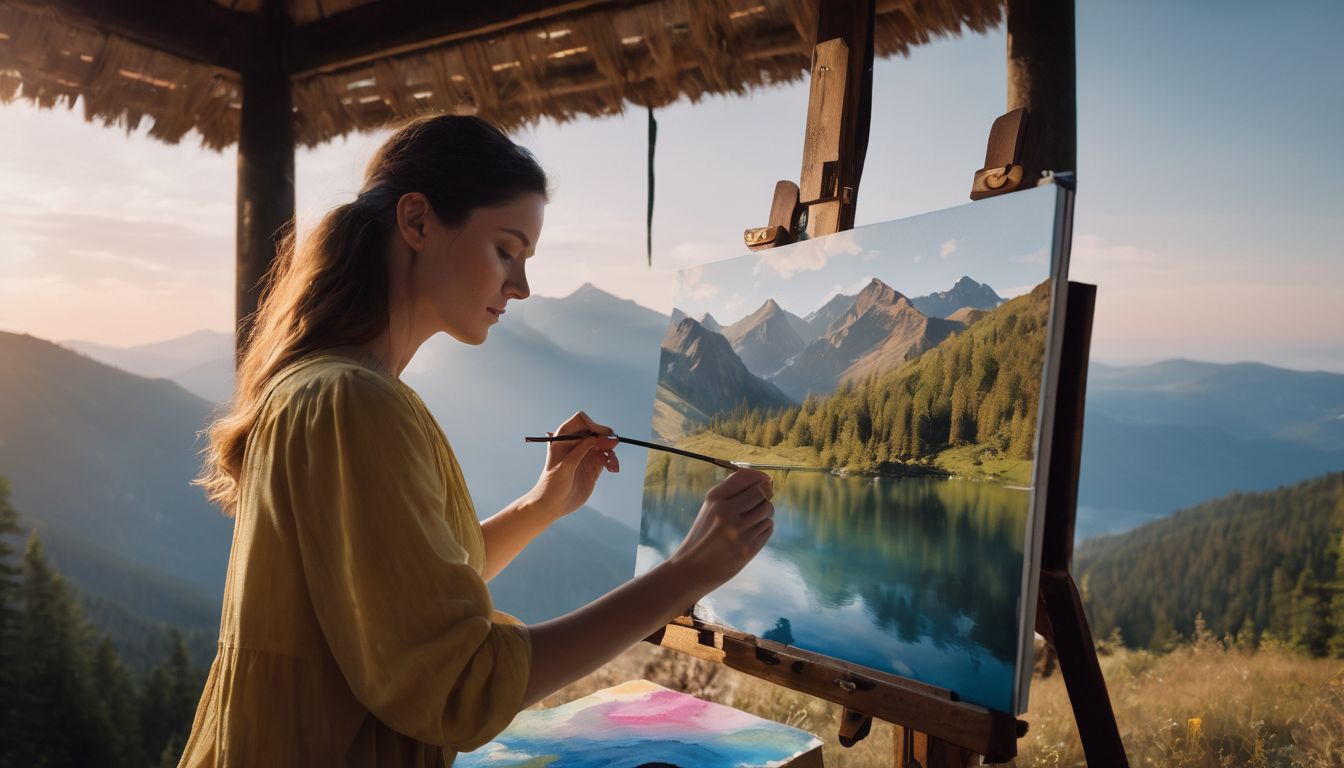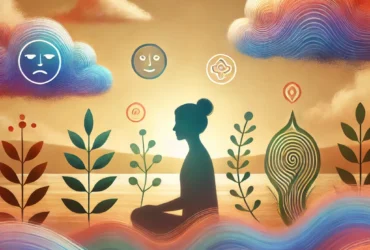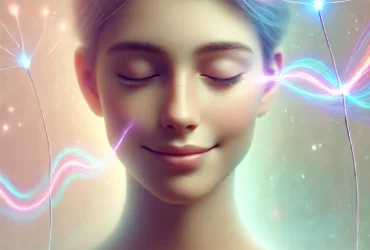Feeling overwhelmed with creativity can be tough for highly sensitive people. These individuals often experience the world more intensely, thanks to their deep emotional and sensory processing.
This guide will show HSPs how to channel their unique qualities into a vibrant creative life, without the burnout. Let’s unlock your artistic brilliance!
Key Takeaways
- Highly sensitive personalities (HSPs) experience the world more intensely due to their deep emotional and sensory processing, which can directly impact their creative impulses and expression.
- HSPs can maximize creativity by embracing moments of stillness, designating specific time for creative pursuits, and minimizing distractions to harness their vivid imagination and deeply felt emotions.
- Nurturing creativity for HSPs involves taking note of inspiration from various sources, exposure to diverse forms of creativity triggers, starting with small creative activities, and building a community of like-minded individuals for support and collaboration.
Understanding Highly Sensitive Personalities and Creativity

HSPs are individuals who experience the world differently and have a substantially more significant filtration system, which can directly impact their creative impulses and expression.
Defining HSPs
Highly sensitive people, or HSPs, have a special way of experiencing the world. They feel things deeply and notice more in their surroundings than others often do. This sensitivity comes from their nervous system that takes in everything around them with far greater intensity.
Subtle details that most folks might miss stand out to an HSP, like soft sounds or faint smells.
The deep feelings and strong emotions that come with high sensitivity are part of who they are. While being highly sensitive can sometimes make life a bit harder, like getting easily overwhelmed by busy noise or too much going on at once, it also gives HSPs a unique view of the world differently which feeds into their creative side.
They may see colors more vividly or hear music in a way that stirs up new ideas for creating something amazing.
Traits of Highly Sensitive Personalities
Highly Sensitive Personalities (HSPs) feel things deeply. They have unique traits that make them special.
- Deep Thinkers: HSPs spend lots of time thinking. They often think about big ideas and the meaning of life.
- Very Empathetic: These people can feel what others are feeling. If someone is sad, they might feel sad too.
- Sensitive to Stimuli: Loud noises or bright lights can be too much for them. They need calm places to feel good.
- Detail-Oriented: HSPs notice little things others miss. This helps them see the world in a special way.
- Easily Overwhelmed: When there’s too much going on, they can get stressed. Quiet time helps them recover.
- Intuitive: They often just “know” things without being told. Their gut feelings are usually right.
- Need Alone Time: To recharge, HSPs like to be by themselves. This helps them deal with their deep feelings.
Link between HSPs and Creativity
HSPs often find themselves drawn to creative activities. Their deep feelings and sharp senses mean they notice more in the world around them. This can lead to new ideas and ways of seeing things that spark creativity.
Also, because HSPs feel emotions strongly, they can put a lot of heart into their art or writing. They use their big feelings to make work that touches other people deeply. For these reasons, many artists and writers are highly sensitive people.
Having a strong inner life helps HSPs in their creative process. They pay close attention to their own internal process which gives them special insight. This means they might come up with unique solutions or beautiful creations that others don’t think of.
But sometimes, HSPs struggle with self-doubt or fear that holds them back from sharing their talents. It’s important for highly sensitive people to learn how to manage these fears so their creativity can shine through.
Ways for HSPs to Maximize Creativity

Embracing “doing nothing” to give the mind space to wander and explore creative impulses.
Embracing “doing nothing”
Highly sensitive personalities (HSPs) can unlock their creative potential by embracing moments of stillness and quiet. Taking time for solitude allows HSPs to recharge and tap into their own creative impulses.
By letting go of distractions, they create space for fresh ideas and inspiration to flow, leading to more innovative and authentic creative endeavors.
Designating regular periods of restful “doing nothing” time provides the mental clarity needed for HSPs to focus on their creative expression without self-doubt or external pressures impeding their energy.
Designating creative alone time
After embracing the concept of “doing nothing,” highly sensitive individuals can benefit from designating specific time for creative pursuits. By setting aside dedicated periods for creativity, HSPs can tap into their vivid imaginations and deeply felt emotions to produce meaningful and authentic work.
Creating a designated space or time for creative endeavors allows highly sensitive personalities to channel their sensitivity into artistic expression without outside interference or distractions.
This intentional allocation of alone time fosters a conducive environment for HSPs to explore their wildly vivid color palate and cultivate their unique perspective, ultimately leading to greater creative success.
Minimizing distractions
To optimize creativity, minimizing distractions is crucial for highly sensitive personalities. Here are strategies to achieve this:
- Create a designated workspace free from noise and clutter.
- Set specific times for focused work without interruptions.
- Utilize noise – canceling headphones or calming background music.
- Prioritize tasks and limit multitasking to maintain concentration.
- Communicate the need for uninterrupted creative time to those around you.
- Use technology mindfully, including setting limits on notifications and social media usage.
- Practice mindfulness or meditation to center your focus and reduce mental clutter.
- Establish boundaries with others to protect your creative energy.
Nurturing Creativity for HSPs
Taking note of inspiration, exposure to creativity triggers, and starting with the first step are essential for nurturing creativity in highly sensitive personalities. Want to learn more? Keep reading!
Taking note of inspiration
Noticing inspiration is crucial for highly sensitive personalities (HSPs) to fuel their creativity. HSPs can capture inspiration from various sources, such as nature, meaningful conversations, art, or music.
Keeping a journal or using a digital note app to record these moments of inspiration can serve as a valuable resource when feeling creatively stuck. By acknowledging and preserving these sparks of creativity, HSPs can tap into them during moments of self-doubt or low motivation to reignite their creative spirit and drive.
Exposure to diverse forms of creativity triggers is essential for nurturing the creative potential of HSPs. Engaging with different art forms like literature, visual arts, music, or performances can stimulate fresh ideas and perspectives.
Exposure to creativity triggers
After taking note of inspiration, highly sensitive personalities can benefit from exposure to creativity triggers. Here are some ways HSPs can find and immerse themselves in creativity triggers:
- Visiting art galleries and museums to explore different forms of artistic expression.
- Surrounding themselves with nature and natural beauty to stimulate their senses and inspire creativity.
- Attending live performances such as concerts, plays, or dance recitals to experience the power of live artistry.
- Engaging in diverse cultural experiences like trying new cuisines, attending cultural festivals, or exploring different traditions.
- Reading a wide variety of literature, including fiction, poetry, and non – fiction to capture the essence of different writing styles and perspectives.
- Listening to various genres of music to evoke emotions and provoke imaginative thinking.
- Participating in workshops or classes that encourage hands – on creative exploration such as painting, pottery, or crafting.
- Collaborating with other creative individuals through networking events or joining creative communities for shared inspiration.
- Exploring innovative technologies and digital platforms that showcase inventive ideas and designs.
- Reflecting on personal experiences and emotions through journaling or expressive writing to tap into inner creativity.
Starting with the first step
To kickstart your creative journey, the first step for highly sensitive personalities is to start small. Begin with simple creative activities that bring joy and inspiration, like doodling, taking nature walks, or experimenting with new recipes.
By initiating these small steps, you can gradually build confidence in your creative abilities and reduce self-doubt. These initial actions can act as a gateway to more complex and fulfilling creative pursuits that align with your highly sensitive soul.
Moving forward from this foundational step of beginning small, let’s delve into nurturing creativity for HSPs by taking note of inspiration.
Building a Community of Creativity for HSPs
Highly sensitive personalities (HSPs) can benefit from connecting with a community of like-minded individuals to nurture their creativity. Joining online forums, social media groups, or local meetups specifically tailored for HSPs and creative individuals can provide valuable support and inspiration.
These communities offer a space where HSPs can share experiences, exchange creative ideas, and receive encouragement without feeling overwhelmed by excessive stimuli. Engaging with such communities helps combat self-doubt and imposter syndrome by fostering a sense of belonging among highly sensitive creatives.
Encouraging collaboration within these communities allows for the sharing of different perspectives and techniques, further enriching the creative process for highly sensitive individuals.
Additionally, collaborating with others who understand the unique challenges faced by HSPs fosters an environment that promotes self-care and mental well-being while pursuing creativity.
Conclusion
In conclusion, embracing the unique traits of highly sensitive personalities can unlock a world of creativity. By recognizing the need for designated creative alone time and minimizing distractions, HSPs can nurture their creative potential.
Additionally, noting inspiration, exposing oneself to creativity triggers, and taking that first step are crucial in building a community of creativity for highly sensitive individuals.
Ultimately, understanding and supporting these strategies can help highly sensitive people thrive in their creative pursuits.
FAQs
1. What is a highly sensitive personality?
A highly sensitive personality, often called HSP, means some people feel things more deeply and think about them a lot. They have a sort of big filter in their brain that takes in sounds, sights, and feelings very strongly.
2. How do creative people benefit from being highly sensitive?
Creative people who are also highly sensitive can use their ability to notice small details and deep emotions to make art or ideas that many others like and understand.
3. Can HSP creativity lead to self-doubt?
Yes, sometimes HSPs doubt themselves because they feel so much and might worry if what they create is good enough.
4. Why should HSPs take care of their mental health?
Because they take in so much around them, it’s important for HSPs to look after their minds just like how we need sleep or healthy food for our bodies.
5. Are there coaches who help highly sensitive creative people?
Yes! There are a few coaches out there whose job is mainly helping these kinds of creative folks thrive by teaching them ways to handle lots of feelings and thoughts while doing their art or work well.
6. Does Elaine Aron write about highly sensitive personalities?
Elaine Aron writes books all about being super-sensitive which many HSps find helpful when trying to figure out the best way to live happily with all the extra stimuli they directly experience every day.






Leave a Reply